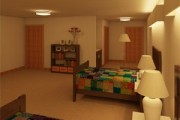 2015-11-13
2015-11-13
Older adults in long-term care facilities often spend their days and nights in dimly-lit rooms with minimal time spent outdoors. The constant, unvarying dim light found in many long-term care facilities means that older adults are not experiencing the robust daily patterns of light and dark that synchronize the body’s circadian clock to local sunrise and sunset. Disruption of this 24-hour rhythm of light and dark affects every one of our biological systems from DNA repair in single cells to melatonin production by the pineal gland, to electrical activity in the brain.
Continue reading →
 2015-11-13
2015-11-13